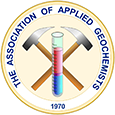Current Status of Applied Geochemistry Research in Chile
SEPT 30, 2010: Brian Townley, AAG Regional Councillor for Chile (btownley@ing.uchile.cl)
As common knowledge states, “no news, good news”, it’s been quite a while since this regional councilor has provided an update of happenings in geochemistry in Chile, my apologies to all. As I am sure in most of the world as here, mining exploration activities have been extremely active lately, “time” most likely today one of the most precious and scarce commodities. The good news is there is no shortage of work around this corner of the world, the problem, barely sufficient time to do it all. Having recently finished project AMIRA P778 Predictive Geochemistry in Areas of Transported Overburden, a joint CSIRO – University of Chile effort, I am happy to mention that results regarding the comprehension of processes of development of geochemical contrast anomalies from buried ore deposits at surface through transported overburden indicate important advancements, in particular on the understanding of ore rock oxidizing processes at source (chemical and microbial), groundwater – ore rock interaction, metal dispersion processes in ground water and mechanisms of transport from source to surface. An important effort was also placed on the understanding of regolith and landscape evolution in northern Chile and the specific geochemical signatures produced by these land forming processes. These studies were aimed at discriminating surface geochemical signatures from those resulting from dispersion processes from ore deposits beneath cover. Results of project AMIRA P778 are currently confidential.
Another AMIRA project in Chile is currently on-going, carried out by the University of Concepción, project AMIRA P972 Mineral Chemistry Applied to Exploration of Ore Deposits, aimed at the development of cost-effective mineral chemistry tools in the understanding of mineralizing systems and how these tools can be applied to determination of hydrothermal vectors to ore zones. This project has collaboration from CSIRO, Aarhus University and University of Oklahoma.
In other topics, major efforts have been placed on geochemistry applied to geothermal exploration and evaluation, a center for geothermal energy research having been formed at the Department of Geology of the University of Chile. In mining, the recent creation of the Advanced Mining Technology Center (AMTC) at the Faculty of Physics and Mathematical Sciences of the University of Chile is among some of the important efforts in mining related research. This center is formed by the departments of Electrical, Mining and Civil engin eering, and the departments of Geology and Geophysics, covering research areas in automatization, mineral characterization, ore resource evaluation, geostatistics, hydro resources, sustainable development and mineral exploration. The AMTC is in its first year, funding allocated for a total of 5 years.
Other areas of research and development include environmental geochemistry, carried out at the Catholic University of the North, University of La Serena, University of Concepción and more recently, here at the University of Chile. At the University of Chile three new academics are being hired, aimed at developing research and education in hydro resource topics, including hydrogeochemistry. Research in geochemistry and mineral characterization has also opened new areas in our department, including archaeology, chemical and particulate contamination associated to mining and smelter activity, geomineralmetallurgy, applications to the wine industry, among many other topics.
All in all, earth sciences are currently among the hot topics in Chile. Nature, through unfortunate events, has moved public consciousness to a desire of better understanding of natural events such as the most recent 8.8 Richter scale earthquake of south-central Chile, previous to this, the eruption of the Chaiten volcano in southern Chile, and most recently, the entrapment of 33 miners at a depth of 700 m in the San José Mine (alive and in the process of successful rescue), near Copiapó. These events have placed geologists in the public eye, and have had impact in government public policies, research deemed most important in a country that economically depends on its natural resources, and that is naturally exposed to seismic and volcanic risk, among others. Plenty of work and insufficient human resources are the main preoccupation at present. Recent press articles indicate that in the mining industry alone, within the next 5 years, a total deficit of over 12.000 workers is expected. Pressure for more research and education is very high, meeting demand from industry a hard task at present.
